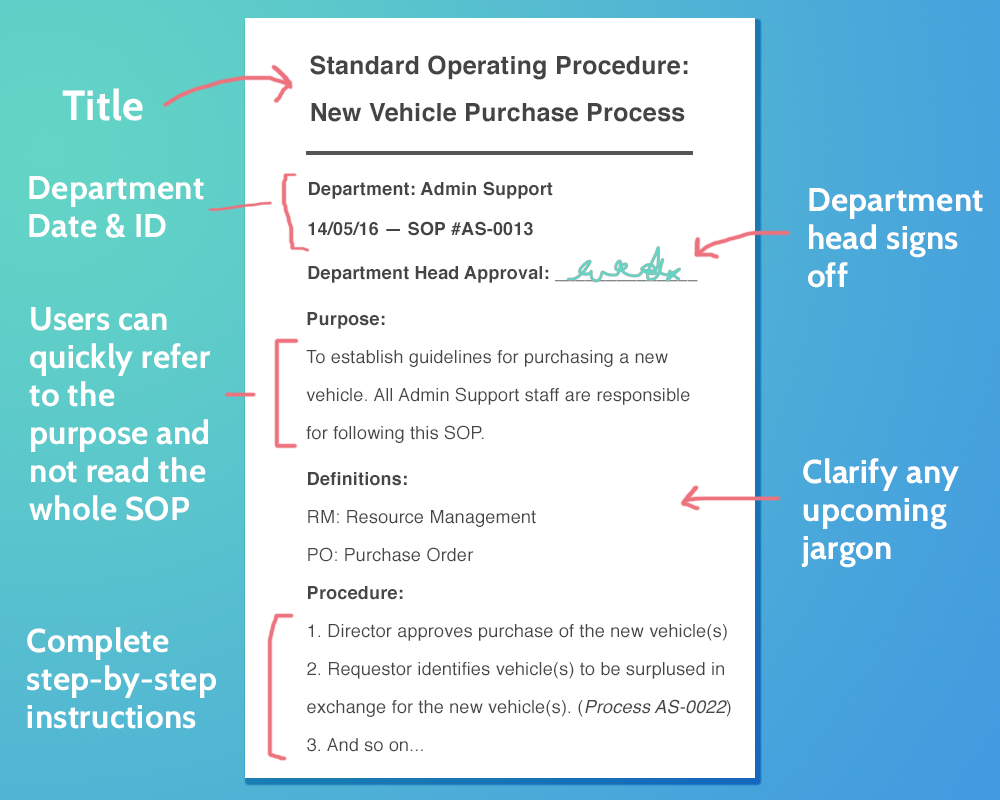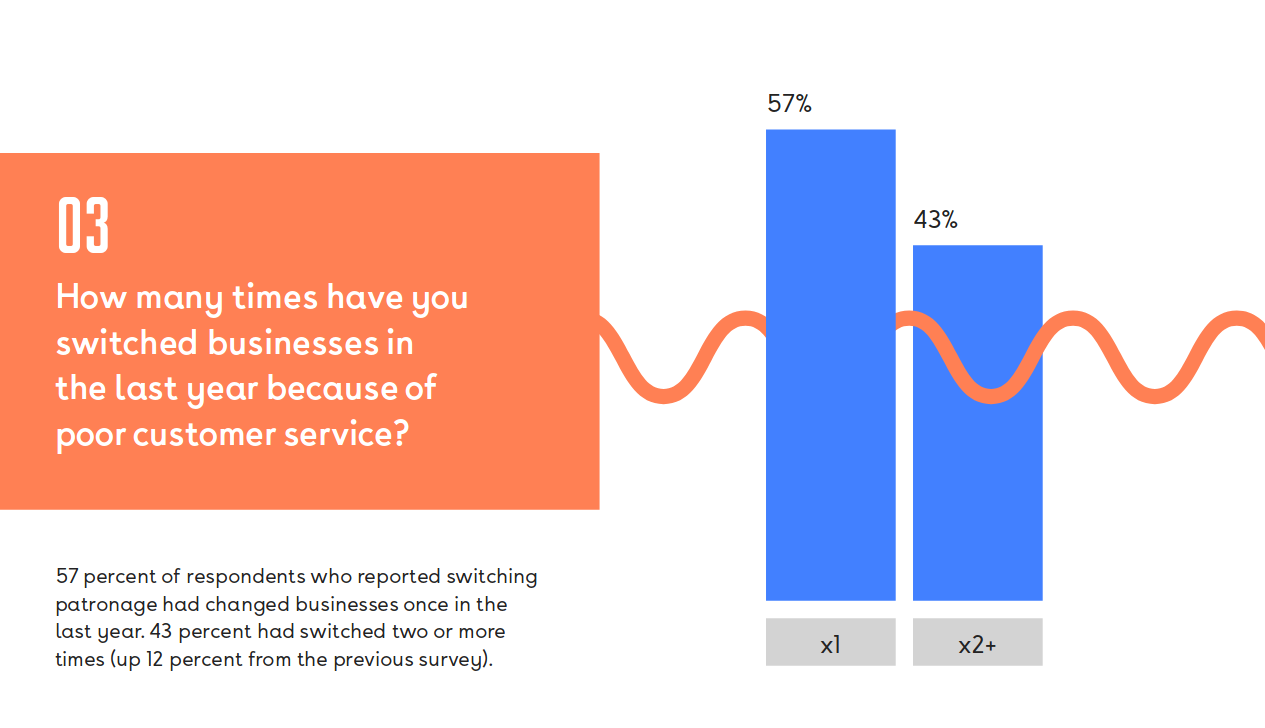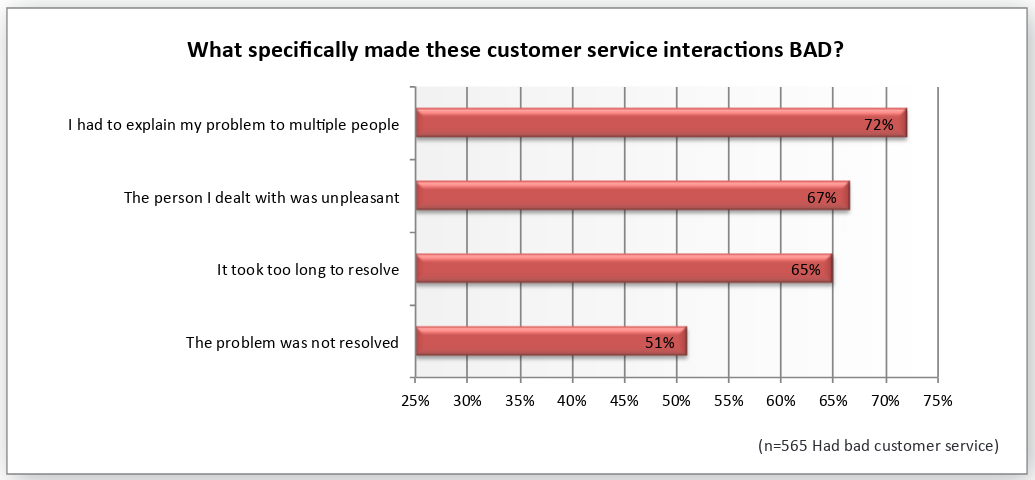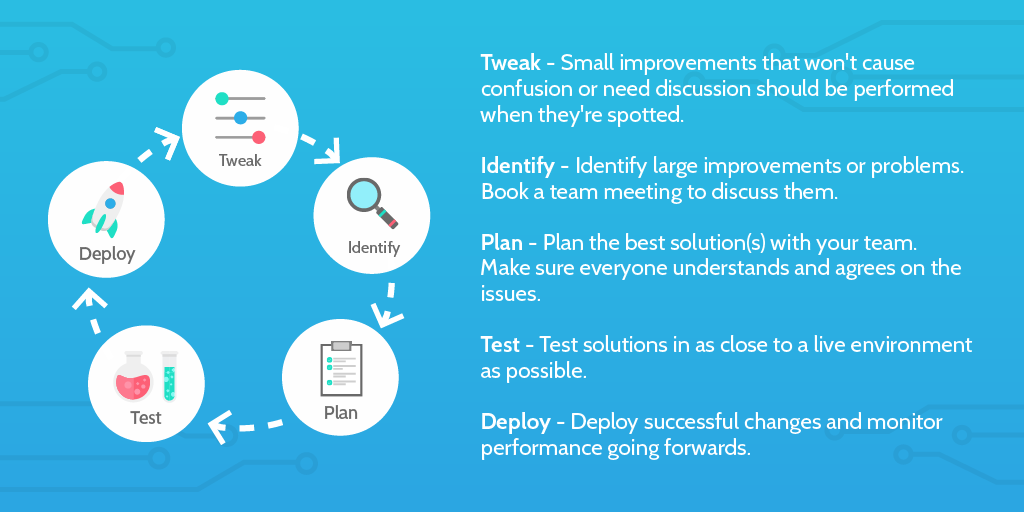
Would you agree to fly on a plane knowing that the crew was simply ‘told’ what to do but didn’t use clear guidelines and instructions?
Probably not.
Sadly, that is how many organizations operate today – without realizing that it may result in a wide range of negative consequences, from employee inefficiency to lost customers and profits.
Telling employees what to do is not nearly as effective as having a set of written step-by-step instructions they can follow, explaining how exactly routine operations should be performed. That’s where standard operating procedures, or SOPs, come in.
What are standard operating procedures (SOPs)?
A standard operating procedure (SOP) is a detailed document companies compile to help their employees effectively handle processes and respond appropriately in a variety of possible scenarios. Usually, the scope of one SOP is one process, like onboarding a new employee or ordering stock:

SOPs are aimed to increase employee productivity and performance, reducing miscommunication and eliminate errors, improve compliance with industry guidelines, and safeguard the quality of customer support. SOPs are what smart businesses use to scale and create consistency in how processes and tasks are performed.
Not convinced?
Seven undeniable benefits of SOPs and how they can improve your customer service
“Customers don’t expect you to be perfect. They DO expect you to fix things when they go wrong.” – Donald Porter
No matter the size of your organization, establishing effective SOPs can make things easier for everyone involved – business owners, managers, customer service employees, and ultimately the customers. And while your clients may not ever see your SOPs in a written form, they will most likely be able to tell whether or not you have them in place by the way your business operates. Here are 7 major reasons to have clearly defined standard operating procedures and how they can help you improve your customer support.
SOPs facilitate effective communication and ensure support quality

According to the recent NewVoiceMedia’s 2018 “Serial Switchers” report, poor customer service is costing businesses more than $75 billion a year (which is up $13 billion since its last report in 2016). What accounts for bad support? While there might be numerous factors affecting service quality and customer satisfaction, one of the fundamental obstacles standing in the way of efficient communication between your customers and your service team is when the agents simply don’t know what to do, especially when things go wrong.
Having well-outlined service SOPs ensures that each member of your customer support team has a clear understanding of what is expected of them at every stage of the service journey and knows how to appropriately respond in any given situation. This could include answers to standard questions, clarity about the way a customer should be spoken to on the phone, via email, or through live chat, instructions on how to handle common complaints and challenging service queries, and more.
SOPs help to deliver consistency in every service interaction

Today’s highly demanding consumers expect to receive efficient, effective, and consistent customer service each and every time, which is proved by numerous researches. In fact, the State of the Connected Customer Report by Salesforce revealed that as much as 81% of consumers expect the same level of service every time they interact with a company across different channels, while 75% expect companies to provide consistent experiences wherever they engage, whether on a website, social media, mobile or in person. Are your service agents able to deliver that consistency?
This is where standard operating procedures become invaluable. Well-structured and easily accessible SOPs will guide your customer support agents on how to effectively handle every service interaction on every support channel, ensuring consistency with the level of customer care delivered by each employee of your support team. This is especially critical when it comes to dealing with complicated customer service issues that require non-standard solutions.
SOPs simplify customer support training and empower new employees
Standard operating procedures allow you to train new customer support agents faster and more effectively. When SOPs are the foundation of training, new support employees don’t have to rely merely on what they heard and saw during the onboarding process. Instead, they learn that when in doubt, they can always refer to the step-by-step guide to find the best way to handle each situation and reduce the chances of mistakes.
The ThinkJar survey found that 84% of customers are frustrated when the service agent does not have information. It also revealed that 13% tell 15 or more people if they’re unhappy. SOPs empower new service agents to become more knowledgeable in a shorter amount of time and ensure they know exactly how to respond in various customer service scenarios, even though they don’t have much experience yet.
SOPs increase performance and productivity of your support agents

Did you know that according to the 2018 Customer Service Benchmark report by SuperOffice, only 20% of companies are able to answer questions in full on the first reply, while the average response time to handle a customer service request is over 12 hours?
With proper SOPs in place, you will have more competent employees who can effectively handle support requests in the fastest time possible. When your support agents know exactly what to do, time isn’t wasted. Getting more work done more efficiently equals increased performance and productivity and eventually leads to improved customer satisfaction.
SOPs allow you to manage customer support employee performance and recognize those who perform better. In fact, without documented SOPs that enforce structured reviews, evaluating job performance often becomes a matter of opinion. With SOPs, managers and team leaders can easily and clearly measure the success of their support agents and identify where they need to improve their skills and knowledge in order to increase employee performance.
SOPs help to boost confidence and capability of your customer support employees

Successful customer support is heavily influenced by confidence – it’s one of the most important components of delivering great service. In fact, confidence is closely tied to competence. Incompetent service agents who are not able to resolve an issue quickly, effectively, and during a single interaction become the main source of frustration for customers. A Zendesk survey actually revealed that 72% of customers blame poor customer service for having to explain their issue multiple times.
Well-designed SOPs create a great foundation of competence for your customer support employees, serving as a roadmap for how to effectively resolve customer queries, from simple to the most complicated ones. This translates into improved employee confidence. A service agent who knows what to do and how to do it efficiently will definitely be more confident and will bring that confidence into each customer service interaction, which will further result in increased customer satisfaction.
SOPs improve support team management and ensure business continuity
When it comes to managing a customer service team, one common challenge leaders face is when a key team member resigns, goes on leave, or simply needs to be away from the office for a certain period of time. No matter what happens within your support department, your customers still demand consistently great experience. Otherwise, they will take their business elsewhere. A recent PwC survey claims that almost one in three consumers (32%) are ready to leave the brand they love after just one bad customer experience.
In cases of an extended employee absence, written SOPs make it easier for managers to delegate responsibilities to other support team members. By referring to the SOPs manual, not only will another employee be able to easily take over the urgent tasks of an absent colleague, but most importantly, they will have a clear understanding of performing those tasks correctly. That ensures business continuity and allows us to deliver a seamless customer service experience.
SOPs help to identify opportunities for improvement

Achieving excellent customer service is a continuous process of learning and improving that never stops. A survey conducted by ThinkJar discovered that 66% of consumers who switched brands did so because of poor service, while 85% of customer churn due to poor service was actually preventable. When your business operates based on standard operating procedures, they not only ensure consistency of your support quality but also allow you to identify opportunities for improving your internal processes and preventing mistakes, which could further help to improve your customer service experience.
In fact, SOPs can be a very powerful tool for evaluating your current customer service practices and deciding how to move forward. Ideally, your service SOPs should be reviewed at least every six months to determine if something needs to be changed in the way your customer service is handled. In addition, the SOPs should be audited when the same errors happen in order to prevent their recurrence.
5 steps to creating effective SOPs for your customer support department
Now that you know why your business needs to have well-established standard operating procedures and how they can impact your customer support quality, you are probably wondering what to start with. As a matter of fact, developing effective SOPs requires thorough preparation before you can even begin composing the document.
Need inspiration to start?
Here’s Process Street’s support process, created to help train new support agents to categorize tickets, use saved replies for consistency, and escalate tickets where appropriate:
To create your own support processes for your department, here are 5 steps to follow:
Get your support employees involved in the conversation
While you may have a good general understanding of what the process consists of, chances are you don’t know all the small but very important details that can affect the outcome. To get the procedure described correctly, talk to your customer support employees, who actually perform it on a daily basis. Allowing them to be part of the process will also make them feel more personally invested in the company’s performance and success.
Plan the process and produce the first draft
Decide on the right format for the SOPs document and write down the exact tasks and how they need to be completed for the process to be successful. Whether it’s a checklist, a step-by-step guide, or a workflow diagram, make your writing concise, easy to read, and understandable for everyone involved. To be user-friendly, SOPs should be clear, unambiguous, and written in plain language while also keeping a positive tone.
Test the SOPs and make improvements if needed
Poorly-written SOPs are a source of misinformation. Once the first draft is created, have someone test the procedure performing each step exactly as described. Make sure the instructions are logical, easy to follow, provide only relevant information, and actually facilitate in completing a certain task. It will also be very helpful to test the procedure on someone who has never done it before and therefore cannot rely on their knowledge and previous experience. If needed, make the necessary changes and improvements.
Train employees to follow the SOPs
Make the SOPs document easily accessible to all the members of your customer support department so that they can refer to it whenever they need it. Then, ensure all your current support employees are properly trained to follow the SOPs. The document will also be a great tool for quick and efficient onboarding and training of new agents who will join your customer support team in the future.
Continuously review and update the SOPs document

Once the SOPs manual is created, it should be thought of as a living document that needs to be reviewed, improved, and updated on a regular basis to remain relevant and useful. Your customer support employees should feel comfortable making updates and adjustments to the SOPs based on the changing needs of the company and customers’ demands. After all, their own productivity, performance, and efficiency rely on it.
Get started now with these pre-made customer service SOPs
With detailed SOPs available, your support agents will have a clear understanding of how to effectively handle common and uncommon support inquiries to ensure that fast, efficient, and consistently great service is delivered in each and every interaction with each and every customer.
But processes can be time-consuming to create from scratch.
That’s why Process Street has hundreds of pre-made processes. You can use and adapt the processes below to help systemize your support team, improve the quality of service, and reduce human error:
- IT Support Process
- Customer Support Process
- Helpdesk Management Process
- IT Service Call Process
- Customer Feedback Survey Process
- Call Center Employee Onboarding Process
- General Employee Onboarding Process
- Performance Management Process
Let me know in the comments – does your company have standard operating procedures in place? If not, what stops you from establishing them?
The following is a guest contribution from Mary Shulzhenko. Mary is a digital marketer, content strategist, and copywriter. She is passionate about writing on customer service, customer experience, small business, marketing, and a variety of other business topics. She provides the original content for LiveAgent, an award-winning and the most-reviewed help desk software for SMBs in 2018. You can find her on LinkedIn.







 Workflows
Workflows Projects
Projects Data Sets
Data Sets Forms
Forms Pages
Pages Automations
Automations Analytics
Analytics Apps
Apps Integrations
Integrations
 Property management
Property management
 Human resources
Human resources
 Customer management
Customer management
 Information technology
Information technology



Benjamin Brandall
Benjamin Brandall is a content marketer at Process Street.